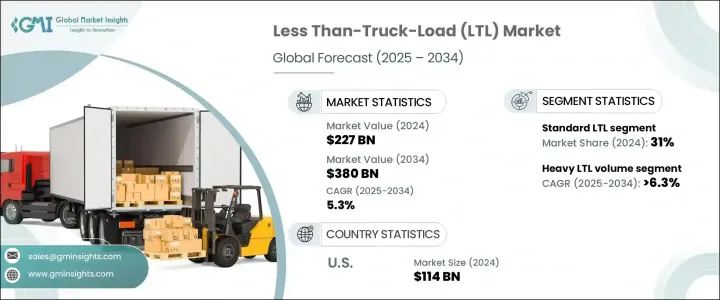
|
시장보고서
상품코드
1755234
세계의 소량 화물 운송 시장 기회 : 성장 촉진요인, 산업 동향 분석 및 예측(2025-2034년)Less Than-Truck-Load (LTL) Market Opportunity, Growth Drivers, Industry Trend Analysis, and Forecast 2025 - 2034 |
||||||
세계의 소량 화물 운송(LTL) 시장은 2024년에는 2,270억 달러로 평가되었고, 특히 중소기업(SME) 사이에서 효율적이고 비용 효율적인 화물 운송에 대한 수요가 높아지고 있는 것을 배경으로, 2034년까지는 3,800억 달러에 달할 것으로 예상되며, CAGR 5.3%로 성장할 전망입니다.
전자상거래의 급속한 성장과 소비자들의 빠른 배송 및 유연한 배송 옵션에 대한 수요는 LTL 서비스를 현대 물류의 핵심으로 부상시켰습니다. 이러한 서비스는 소규모 화물을 통합하여 운송 비용을 최적화하고 연료 소비를 줄이며 지속 가능성을 향상시킵니다.

전자상거래가 성장함에 따라 특히 온라인 소매업체를 포함한 더 많은 기업들이 소비자의 빠른 배송 및 저렴한 비용에 대한 기대를 충족시키기 위해 LTL에 의존하고 있습니다. 도시화는 LTL 시장을 촉진하는 또 다른 주요 요인으로, 인구 밀도가 높은 도시 지역에는 효율적이고 소규모의 화물 운송 솔루션이 필요합니다. LTL 운송업체는 도시 내 배송을 관리하고, 대량 배송이 어려운 혼잡한 지역을 운행하는 데 특히 능숙합니다. 전자상거래 및 도시 물류에서 발생하는 핵심 수요 외에도 소매 및 제조와 같은 산업도 효율적인 지역 및 라스트 마일 유통을 지원하기 위해 LTL 서비스로 점점 전환하고 있습니다. 이 분야들은 LTL의 유연성과 비용 우위를 활용해 재고 보충이나 변동하는 고객 수요에 대응하기 위해 자주 소량 배송을 진행할 수 있습니다. 기업들이 정시 배송 모델을 우선시하고 창고에서 매장까지의 네트워크를 최적화함에 따라 LTL은 공급망의 핵심 요소로 자리매김하고 있습니다.
| 시장 범위 | |
|---|---|
| 시작 연도 | 2024년 |
| 예측 연도 | 2025-2034년 |
| 시작 금액 | 2,270억 달러 |
| 예측 금액 | 3,800억 달러 |
| CAGR | 5.3% |
2024년에는 표준 LTL 부문이 31%의 점유율로 시장을 주도했으며, 2034년까지 연평균 6.4%의 성장률을 보일 것으로 예상됩니다. 이 부문의 인기는 경제성, 신뢰성, 다양한 산업 요구 사항과의 호환성에서 비롯됩니다. 통합 배송 모델을 통해 여러 기업이 운송 공간을 공유할 수 있어 배송당 비용이 크게 절감되고 전체 차량의 효율성이 향상됩니다. 따라서 정기적으로 소량의 화물을 운송하는 중소기업에 특히 매력적입니다.
동시에, 중량 LTL 부문은 2024년에 77%의 점유율을 차지했으며, 2034년까지 연평균 6.3%의 성장률을 보일 것으로 예상됩니다. 7,000-20,000파운드의 화물을 처리하도록 설계된 이 부문은 특히 기계, 소비재 및 산업 장비와 같은 분야에서 전체 트럭 운송 서비스에 대한 비용 효율적인 대안을 필요로 하는 기업에 서비스를 제공합니다. 이 부문의 가치 제안은 미사용 용량의 비용 부담 없이 대량 운송 솔루션을 제공하는 데 있습니다.
미국의 소량 화물 운송(LTL) 시장은 2024년에 1,140억 달러의 매출을 올렸습니다. 이 시장의 선두는 고도로 발달된 화물 운송 네트워크, 확장되는 전자상거래 부문, 인프라 개선에 대한 연방 정부의 대규모 투자에 의해 촉진되고 있습니다. 디지털화, 스마트 라우팅 기술의 발전, 자동화 물류 시스템의 부상은 LTL 부문에서 미국의 지배적 위치를 더욱 공고히 하고 있습니다.
세계의 LTL 시장의 주요 기업은 XPO Logistics, TForce Freight, FedEx Freight, RL Carriers, Old Dominion Freight Line, ABF Freight, Estes Express Lines, Averitt, Southeastern Freight Lines, SAIA LTL Freight 등이 있습니다. 경쟁이 치열한 LTL 시장에서 기업들은 시장 지위를 강화하기 위해 다양한 전략을 채택하고 있습니다. 이는 다양한 산업과 화물 유형에 맞는 서비스 확대, 실시간 추적과 같은 고급 기술 투자, 경로 최적화 통합을 통해 효율성을 높이는 것을 포함합니다. 또한 많은 기업들이 중소기업의 특정 요구 사항을 충족하는 유연하고 맞춤화된 배송 솔루션을 제공하여 고객 경험을 개선하고 있습니다. 또한, 차량의 현대화를 통해 지속 가능성에 집중하고 탄소 배출량을 줄이는 것이 점점 더 많은 동향으로 나타나고 있습니다. 이러한 기업들은 또한 전자상거래 거대 기업 및 제조업체들과 전략적 파트너십을 구축하여 라스트 마일 및 지역 배송 요구를 지원함으로써, 자사의 서비스가 물류 부문의 진화하는 요구 사항에 부합하도록 하고 있습니다.
목차
제1장 조사 방법과 범위
제2장 주요 요약
제3장 업계 인사이트
- 업계 생태계 분석
- 공급자의 상황
- LTL 운송업체
- 운송업자
- 제3자물류 공급자
- 기술 공급자
- 이익률 분석
- 트럼프 정권에 의한 관세에 대한 영향
- 무역에 미치는 영향
- 무역량의 혼란
- 타국에 의한 보복조치
- 업계에 미치는 영향
- 주요 원재료의 가격 변동
- 공급망 재구성
- 전력 출력과 비용에 미치는 영향
- 영향을 받는 주요 기업
- 전략적인 업계 대응
- 공급망 재구성
- 가격 설정과 전력 출력 전략
- 전망과 향후 검토 사항
- 무역에 미치는 영향
- 기술과 혁신의 상황
- 가격 동향
- 코스트 내역 분석
- 특허 분석
- 주요 뉴스와 대처
- 규제 상황
- 영향요인
- 성장 촉진요인
- 전자상거래의 확장
- 산업 성장 및 제조업
- 기술 채택 증가
- 비용 효율적인 솔루션에 대한 호감도 증가
- 3PL(제3자 물류) 제공업체의 확장
- 업계의 잠재적 리스크 및 과제
- 높은 취급 비용
- 운영의 복잡성
- 성장 촉진요인
- 성장 가능성 분석
- Porter's Five Forces 분석
- PESTEL 분석
제4장 경쟁 구도
- 소개
- 기업의 시장 점유율 분석
- 경쟁 포지셔닝 매트릭스
- 전략적 전망 매트릭스
제5장 시장 추계 및 예측 : 서비스별(2021-2034년)
- 주요 동향
- 표준 LTL
- 신속 LTL
- 보장 LTL
- 국경 간 LTL
- 복한 운송 LTL
제6장 시장 추계 및 예측 : 용량별(2021-2034년)
- 주요 동향
- 경량 LTL
- 대량 LTL
제7장 시장 추계 및 예측 : 동작 모드별(2021-2034년)
- 주요 동향
- 자산 기반 운송업체
- 비자산 기반 운송업체
- 하이브리드 운송업체
제8장 시장 추계 및 예측 : 최종 용도별(2021-2034년)
- 주요 동향
- 자동차
- 소비재 및 소매
- 의료 및 의약품
- 산업 및 제조업
- 식품 및 음료
- 기타
제9장 시장 추계 및 예측 : 지역별(2021-2034년)
- 주요 동향
- 북미
- 미국
- 캐나다
- 유럽
- 영국
- 독일
- 프랑스
- 이탈리아
- 스페인
- 러시아
- 북유럽 국가
- 아시아태평양
- 중국
- 인도
- 일본
- 한국
- 호주 및 뉴질랜드
- 동남아시아
- 라틴아메리카
- 브라질
- 멕시코
- 아르헨티나
- 중동 및 아프리카
- 아랍에미리트(UAE)
- 사우디아라비아
- 남아프리카
제10장 기업 프로파일
- ABF Freight
- Averitt Express
- Central Transport
- Dayton Freight Lines
- Estes Express Lines
- FedEx Freight
- Kuehne Nagel
- New England Motor Freight
- Old Dominion Freight Line
- Peninsula Truck Lines
- Pitt Ohio
- RL Carriers
- SAIA LTL Freight
- Seino Transportation
- Southeastern Freight Lines
- TFI International
- TForce Freight
- Ward Trucking
- XPO Logistic
- Yamato Transport
The Global Less Than-Truck-Load (LTL) Market was valued at USD 227 billion in 2024 and is expected to grow at a CAGR of 5.3% to reach USD 380 billion by 2034, driven by the increasing demand for efficient and cost-effective freight transportation, particularly among small and medium-sized enterprises (SMEs). The rise of e-commerce, along with consumers' demand for faster and more flexible delivery options, has placed LTL services at the forefront of modern logistics. These services allow for smaller shipments to be consolidated, which optimizes transport costs, reduces fuel consumption, and enhances sustainability.

As e-commerce rises, more businesses, especially online retailers, rely on LTL to meet growing consumer expectations for swift and affordable delivery. Urbanization is another key factor fueling the LTL market, as densely populated urban areas require efficient, smaller-scale freight solutions. LTL carriers are especially adept at managing intra-city deliveries and navigating congested regions where larger shipments may be impractical. In addition to core demand from e-commerce and urban logistics, industries like retail and manufacturing are increasingly turning to LTL services to support efficient regional and last-mile distribution. These sectors benefit from the flexibility and cost advantages of LTL, which enables frequent, small-batch shipments to replenish inventory or meet fluctuating customer needs without the overhead of full truckloads. As businesses prioritize just-in-time delivery models and optimize warehouse-to-store networks, LTL becomes a critical piece of the supply chain.
| Market Scope | |
|---|---|
| Start Year | 2024 |
| Forecast Year | 2025-2034 |
| Start Value | $227 Billion |
| Forecast Value | $380 Billion |
| CAGR | 5.3% |
In 2024, the standard LTL segment led the market with a 31% share and is poised to grow at a CAGR of 6.4% through 2034. Its popularity stems from its affordability, reliability, and compatibility with diverse industry needs. The consolidated shipping model allows multiple businesses to share transportation space, significantly reducing per-shipment costs while boosting overall fleet efficiency. This makes it especially appealing for small and mid-sized enterprises managing regular but smaller-volume freight.
Simultaneously, the heavy LTL volume segment held a 77% share in 2024 and is projected to grow at a CAGR of 6.3% through 2034. Designed to handle loads between 7,000 and 20,000 pounds, this segment serves companies requiring cost-effective alternatives to full truckload services-particularly in sectors like machinery, consumer goods, and industrial equipment. Its value proposition lies in providing bulk transport solutions without the cost burden of unused capacity.
United States Less Than-Truck-Load (LTL) Market generated USD 114 billion in 2024. Its leadership is driven by a highly developed freight network, an expanding e-commerce sector, and significant federal investment in infrastructure improvements. Enhanced digitization, smart routing technologies, and the rise of automated logistics systems reinforce the country's position as a dominant force in the LTL sector.
Key players in the Global Less Than-Truck-Load (LTL) Market include XPO Logistics, TForce Freight, FedEx Freight, R+L Carriers, Old Dominion Freight Line, ABF Freight, Estes Express Lines, Averitt, Southeastern Freight Lines, and SAIA LTL Freight. In the competitive LTL market, companies are increasingly adopting strategies to solidify their market positions. This includes expanding service offerings to cater to different industries and freight types, investing in advanced technologies like real-time tracking, and integrating route optimization to boost efficiency. Many companies are also enhancing their customer experience by offering flexible and tailored delivery solutions that meet the specific needs of small- to medium-sized businesses. Additionally, focusing on sustainability through fleet modernization and reducing carbon emissions is a growing trend. These companies are also forging strategic partnerships with e-commerce giants and manufacturers to support last-mile and regional delivery needs, ensuring that their services align with the evolving demands of the logistics sector.
Table of Contents
Chapter 1 Methodology & Scope
- 1.1 Research design
- 1.1.1 Research approach
- 1.1.2 Data collection methods
- 1.2 Base estimates and calculations
- 1.2.1 Base year calculation
- 1.2.2 Key trends for market estimates
- 1.3 Forecast model
- 1.4 Primary research & validation
- 1.4.1 Primary sources
- 1.4.2 Data mining sources
- 1.5 Market definitions
Chapter 2 Executive Summary
- 2.1 Industry 3600 synopsis, 2021 - 2034
Chapter 3 Industry Insights
- 3.1 Industry ecosystem analysis
- 3.2 Supplier landscape
- 3.2.1 LTL Carriers
- 3.2.2 Shippers
- 3.2.3 Third-party logistics providers
- 3.2.4 Technology providers
- 3.3 Profit margin analysis
- 3.4 Trump administration tariffs
- 3.4.1 Impact on trade
- 3.4.1.1 Trade volume disruptions
- 3.4.1.2 Retaliatory measures by other countries
- 3.4.2 Impact on the industry
- 3.4.2.1 Price Volatility in key materials
- 3.4.2.2 Supply chain restructuring
- 3.4.2.3 Power output and cost implications
- 3.4.3 Key companies impacted
- 3.4.4 Strategic industry responses
- 3.4.4.1 Supply chain reconfiguration
- 3.4.4.2 Pricing and Power output strategies
- 3.4.5 Outlook and future considerations
- 3.4.1 Impact on trade
- 3.5 Technology & innovation landscape
- 3.6 Price trends
- 3.7 Cost breakdown analysis
- 3.8 Patent analysis
- 3.9 Key news & initiatives
- 3.10 Regulatory landscape
- 3.11 Impact forces
- 3.11.1 Growth drivers
- 3.11.1.1 E-commerce expansion
- 3.11.1.2 Industrial growth and manufacturing
- 3.11.1.3 Rising adoption of technology
- 3.11.1.4 Growing preference for cost-effective solutions
- 3.11.1.5 Expansion of 3PL (third-party logistics) providers
- 3.11.2 Industry pitfalls & challenges
- 3.11.2.1 High handling costs
- 3.11.2.2 Operational Complexity
- 3.11.1 Growth drivers
- 3.12 Growth potential analysis
- 3.13 Porter's analysis
- 3.14 PESTEL analysis
Chapter 4 Competitive Landscape, 2024
- 4.1 Introduction
- 4.2 Company market share analysis
- 4.3 Competitive positioning matrix
- 4.4 Strategic outlook matrix
Chapter 5 Market Estimates & Forecast, By Service, 2021 - 2034 ($Bn, Units)
- 5.1 Key trends
- 5.2 Standard LTL
- 5.3 Expedited LTL
- 5.4 Guaranteed LTL
- 5.5 Cross-Border LTL
- 5.6 Intermodal LTL
Chapter 6 Market Estimates & Forecast, By Capacity, 2021 - 2034 ($Bn, Units)
- 6.1 Key trends
- 6.2 Light LTL volume
- 6.3 Heavy LTL volume
Chapter 7 Market Estimates & Forecast, By Mode of operation, 2021 - 2034 ($Bn, Units)
- 7.1 Key trends
- 7.2 Asset-based carriers
- 7.3 Non-asset-based carriers
- 7.4 Hybrid carriers
Chapter 8 Market Estimates & Forecast, By End Use, 2021 - 2034 ($Bn, Units)
- 8.1 Key trends
- 8.2 Automotive
- 8.3 Consumer goods & retail
- 8.4 Healthcare & pharmaceuticals
- 8.5 Industrial & manufacturing
- 8.6 Food & beverage
- 8.7 Others
Chapter 9 Market Estimates & Forecast, By Region, 2021 - 2034 ($Bn, Units)
- 9.1 Key trends
- 9.2 North America
- 9.2.1 U.S.
- 9.2.2 Canada
- 9.3 Europe
- 9.3.1 UK
- 9.3.2 Germany
- 9.3.3 France
- 9.3.4 Italy
- 9.3.5 Spain
- 9.3.6 Russia
- 9.3.7 Nordics
- 9.4 Asia Pacific
- 9.4.1 China
- 9.4.2 India
- 9.4.3 Japan
- 9.4.4 South Korea
- 9.4.5 ANZ
- 9.4.6 Southeast Asia
- 9.5 Latin America
- 9.5.1 Brazil
- 9.5.2 Mexico
- 9.5.3 Argentina
- 9.6 MEA
- 9.6.1 UAE
- 9.6.2 Saudi Arabia
- 9.6.3 South Africa
Chapter 10 Company Profiles
- 10.1 ABF Freight
- 10.2 Averitt Express
- 10.3 Central Transport
- 10.4 Dayton Freight Lines
- 10.5 Estes Express Lines
- 10.6 FedEx Freight
- 10.7 Kuehne + Nagel
- 10.8 New England Motor Freight
- 10.9 Old Dominion Freight Line
- 10.10 Peninsula Truck Lines
- 10.11 Pitt Ohio
- 10.12 R+L Carriers
- 10.13 SAIA LTL Freight
- 10.14 Seino Transportation
- 10.15 Southeastern Freight Lines
- 10.16 TFI International
- 10.17 TForce Freight
- 10.18 Ward Trucking
- 10.19 XPO Logistic
- 10.20 Yamato Transport



















